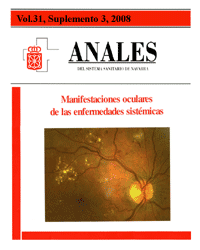Retinal manifestations of infectious diseases
Keywords:
Retinitis. Infecciones sistémicas. Toxoplasma. Herpes. Candidiasis.Abstract
The retina and the choroids are richly vascularised structures and can therefore be colonised by germs via the haematogenous route in the course of a systemic infectious disease. The germs responsible for this type of infection can be fungi, viruses, bacteria and parasites. Ocular candidiasis is outstanding amongst these colonisations because of its frequency; it can manifest itself as an endophthalmitis with a slow and hidden course. The so-called ocular histoplasmosis syndrome, although it is infrequent in our setting, is an important cause of choroidal neovascularisation. The viruses that most frequently affect the retina are of the herpes type and can produce devastating symptoms in immunoincompetent patients, named acute retinal necrosis syndrome. Retinitis due to cytomegalovirus is more frequent in immunodepressed patients, as in the case of AIDS, but it must also be contemplated in patients with lymphoma and immunomodulatory treatment. The most frequent bacterial diseases that affect the retina are syphilis and tuberculosis. Disease due to cat scratches, caused by a borrelia, can produce a neuroretinitis. Toxoplasmosis is the most common of the infectious diseases caused by a parasite and gives rise to chorioretinitis. Toxocariasis, also caused by a parasite, is second in importance, giving rise to choroidal granulomas and retinal tractions.Downloads
Downloads
Published
How to Cite
Issue
Section
License
La revista Anales del Sistema Sanitario de Navarra es publicada por el Departamento de Salud del Gobierno de Navarra (España), quien conserva los derechos patrimoniales (copyright ) sobre el artículo publicado y favorece y permite la difusión del mismo bajo licencia Creative Commons Reconocimiento-CompartirIgual 4.0 Internacional (CC BY-SA 4.0). Esta licencia permite copiar, usar, difundir, transmitir y exponer públicamente el artículo, siempre que siempre que se cite la autoría y la publicación inicial en Anales del Sistema Sanitario de Navarra, y se distinga la existencia de esta licencia de uso.








